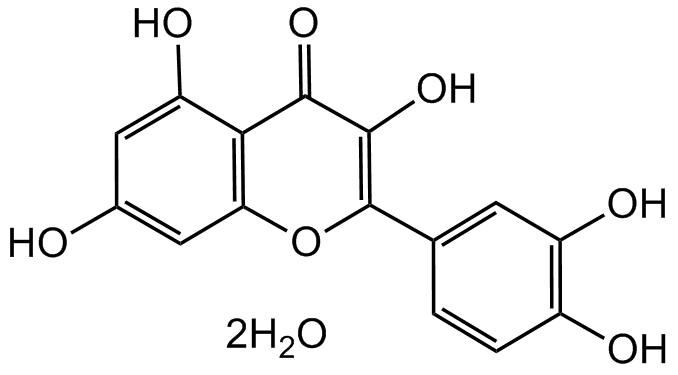Quercetin dihydrate
| Code | Size | Price |
|---|
| CDX-Q0027-G025 | 25 g | £59.00 |
Quantity:
| CDX-Q0027-G050 | 50 g | £89.00 |
Quantity:
Prices exclude any Taxes / VAT
Overview
Host Type: Plant
Regulatory Status: RUO
Shipping:
AMBIENT
Storage:
+20°C
Images
Documents
Further Information
Alternate Names/Synonyms:
3,3',4',5,7-Pentahydroxyflavone dihydrate; Sophoretin; Meletin; Xanthaurine; Quercetol; Quercitin; Quertine; Flavin meletin; NCI-C60106; NSC9219; NSC9221; CI 75670; CI Natural Yellow 10; BRN0317313
Appearance:
Yellow powder.
CAS:
6151-25-3
Class:
6.1
EClass:
32160000
Form (Short):
liquid
GHS Symbol:
GHS06
Handling Advice:
Protect from light and moisture.
Hazards:
H301
InChi:
InChI=1S/C15H10O7/c16-7-4-10(19)12-11(5-7)22-15(14(21)13(12)20)6-1-2-8(17)9(18)3-6/h1-5,16-19,21H
InChiKey:
REFJWTPEDVJJIY-UHFFFAOYSA-N
Long Description:
Chemical. CAS: 6151-25-3. Formula: C15H10O7. 2H2O. MW: 338.27. Quercetin is a natural multipotent flavonoid with antioxidant, anti-inflammatory, anticancer, neuroprotective, cardioprotective, antidiabetic and antiobesity properties. It has been shown to inhibit NF-kappa signaling pathway and the NLRP3 inflammasome activation. It is an apoptosis and autophagy inducer, cell cycle inhibitor, chemosensitizing agent, proteasome inhibitor and activator of SIRT1. It is a pleiotropic kinase inhibitor, including tyrosine protein kinase (Trk), mitochondrial ATPase, cAMP- and cGMP-phosphodiesterases, PI3-kinase activity, phospholipase A2 and protein kinase C (PKC). It is a reversible fatty acid synthase inhibitor.
MDL:
MFCD03847906
Molecular Formula:
C15H10O7 . 2H2O
Molecular Weight:
338.27
Package Type:
Vial
PG:
III
Precautions:
P270, P264, P301, P310, P330, P405, P501
Product Description:
Quercetin is a natural multipotent flavonoid with antioxidant, anti-inflammatory, anticancer, neuroprotective, cardioprotective, antidiabetic and antiobesity properties. It has been shown to inhibit NF-kappa signaling pathway and the NLRP3 inflammasome activation. It is an apoptosis and autophagy inducer, cell cycle inhibitor, chemosensitizing agent, proteasome inhibitor and activator of SIRT1. It is a pleiotropic kinase inhibitor, including tyrosine protein kinase (Trk), mitochondrial ATPase, cAMP- and cGMP-phosphodiesterases, PI3-kinase activity, phospholipase A2 and protein kinase C (PKC). It is a reversible fatty acid synthase inhibitor.
Purity:
>95% (HPLC)
Signal word:
Danger
SMILES:
OC1=C(C2=CC(O)=C(O)C=C2)OC(C=C(O)C=C3O)=C3C1=O
Solubility Chemicals:
Soluble in DMSO (20mg/ml), DMF (20mg/ml) or ethanol (5mg/ml).
Source / Host:
Plant
Transportation:
Excepted Quantity
UN Nummer:
2811
UNSPSC Category:
Natural Products/Extracts
UNSPSC Number:
12352200
Use & Stability:
Stable for at least 2 years after receipt when stored at RT.
References
(1) R. Lupu & J.A. Menendez; Curr. Pharm. Biotechnol. 7, 483 (2006) (Review) | (2) S. Chung, et al.; Arch. Biochem. Biophys. 501, 79 (2010) (Review) | (3) M. Shen, et al.; Anticancer Agents Med. Chem. 12, 891 (2012) (Review) | (4) K. Pallauf & G. Rimbach; Ageing Res. Rev. 12, 237 (2013) (Review) | (5) G.L. Russo; Cancer Treat. Res. 159, 185 (2014) (Review) | (6) S.F. Nabavi, et al.; Food Chem. 179, 305 (2015) (Review) | (7) G. D'Andrea; Fitoterapia 106, 256 (2015) (Review) | (8) Y. Li, et al.; Nutrients 8, 167 (2016) (Review) | (9) D. Kashyap, et al.; Tumour Biol. 37, 12927 (2016) (Review) | (10) D. Barreca, et al.; CNS Neurol. Disord. Drug Targets 15, 964 (2016) (Review) | (11) F. Khan, et al.; Nutrients 8, E529 (2016) (Review) | (12) S. Chen, et al.; Mediators Inflamm. 2016, 9340637 (2016) (Review) | (13) H.M. Eid & P.S. Haddad; Curr. Med. Chem. 24, 355 (2017) (Review) | (14) H. Lim, et al.; Toxicol. Appl. Pharmacol. 355, 93 (2018) | (15) D. Xu, et al.; Molecules 24, E1123 (2019) (Review) | (16) H. Khan, et al.; Biomolecules 10, E59 (2019) (Review)



